Nólsoy | |
|---|---|
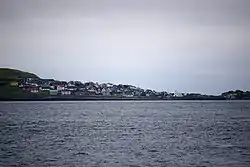 | |
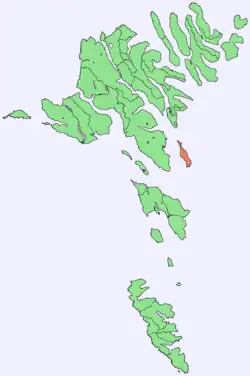 Location within the Faroe Islands | |
| Coordinates: 62°00′33″N 6°40′7″W / 62.00917°N 6.66861°W | |
| State | |
| Constituent country | |
| Municipality seat | Tórshavn Municipality |
| Area | |
| • Total | 10.3 km2 (4.0 sq mi) |
| Highest elevation | 372 m (1,220 ft) |
| Population (2021) | |
| • Total | 230[1] |
| Time zone | UTC+0 (GMT) |
| • Summer (DST) | UTC+1 (EST) |
| Postal code | FO-270 |
| Calling code | 298 |
Nólsoy (previously also Nölsoy; Danish: Nolsø; Old Norse: Norsey) is an island and village with a population of 230 people in central Faroe Islands, 4km east of the capital Tórshavn in Streymoy.
Description
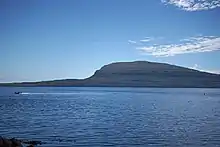
Nólsoy is the lowest of the Faroes; the highest point is Eggjarklettur (372 m) on the mountain Høgoyggj. The southern coast contains two capes, each with a lighthouse (Øknastangi on the south-east, Borðan on the south). The lighthouses were built in the late 18th century to aid smugglers working against the unpopular trading monopoly imposed by Denmark. In 2005, the National Bank of Denmark issued a 20 DKK commemorative coin for the lighthouse.[2]
There is only one settlement on the island, also called Nólsoy, on the north-west coast on the Stongin peninsula which is attached to the rest of the island by a metres-wide isthmus. The small coastal village is made up of colourful homes and buildings, placed extremely close to each other to help shelter each other from storms. The island is accessible by a 20-minute ferry journey from Tórshavn. As many as 40 people that live in Nólsoy go to work in Tórshavn each morning. In recent years many young families have moved from Tórshavn to Nólsoy where the houses are cheaper than in Tórshavn. This way it is possible to live "in the country" and still be only 20 minutes from the capital. Nólsoy is the most populous of the Faroe islands not to have an existing or planned road connection to the rest of the archipelago.
Ruins in Korndalur (Corn Valley) are associated with the legendary Princess of Nólsoy.[3][4]
Etymology
Old Norse nór (genitive nórs) refers to a narrow stretch of land in a body of water.[5]
People from Nólsoy
Nólsoy has an annual civic festival called Ovastevna, held at the beginning of August. Ovastevna is similar to Ólavsøka in Tórshavn only smaller. Ovastevna is held to commemorate Ove Joensen from Nólsoy. He rowed from the Faroe Islands to Denmark in a traditional Faeroese boat in 1986. In 1987 Ove drowned in Skálafjørður-inlet where he fell overboard. The profit from the festival is used to build a swimming pool for the children in Nólsoy. Ove originally started this project after his row to Denmark.
Nólsoyar Páll came from Nólsoy. He is recognized as a kind of freedom fighter and national hero. He fought to end the Royal Trade Monopoly in the beginning of 19th century. The Royal Trade Monopoly was exhausting and impoverishing the people of the Faroe Islands from 1271 to 1856. Nólsoyar Páll carried trade between Denmark and Faroe Islands in his ship ‘Royndin Frida’. His ship was the first Faeroese ocean-going vessel since the early Middle Ages.
Climate
| Climate data for Nólsoy, 80 m.a.s.l. | |||||||||||||
|---|---|---|---|---|---|---|---|---|---|---|---|---|---|
| Month | Jan | Feb | Mar | Apr | May | Jun | Jul | Aug | Sep | Oct | Nov | Dec | Year |
| Record high °C (°F) | 12.1 (53.8) |
10.6 (51.1) |
10.8 (51.4) |
13.3 (55.9) |
18.2 (64.8) |
18.6 (65.5) |
18.0 (64.4) |
17.8 (64.0) |
17.2 (63.0) |
14.0 (57.2) |
12.2 (54.0) |
11.5 (52.7) |
18.6 (65.5) |
| Mean daily maximum °C (°F) | 5.2 (41.4) |
5.5 (41.9) |
5.8 (42.4) |
6.8 (44.2) |
8.8 (47.8) |
10.6 (51.1) |
11.9 (53.4) |
12.2 (54.0) |
10.6 (51.1) |
8.9 (48.0) |
6.8 (44.2) |
5.9 (42.6) |
8.2 (46.8) |
| Daily mean °C (°F) | 3.5 (38.3) |
3.8 (38.8) |
3.9 (39.0) |
4.7 (40.5) |
6.7 (44.1) |
8.5 (47.3) |
9.9 (49.8) |
10.2 (50.4) |
8.8 (47.8) |
7.3 (45.1) |
5.0 (41.0) |
4.0 (39.2) |
6.3 (43.3) |
| Mean daily minimum °C (°F) | 1.2 (34.2) |
1.6 (34.9) |
1.6 (34.9) |
2.5 (36.5) |
4.8 (40.6) |
6.6 (43.9) |
8.2 (46.8) |
8.4 (47.1) |
6.8 (44.2) |
5.2 (41.4) |
2.8 (37.0) |
1.6 (34.9) |
4.3 (39.7) |
| Record low °C (°F) | −7.6 (18.3) |
−6.8 (19.8) |
−8.4 (16.9) |
−6.6 (20.1) |
−2.6 (27.3) |
0.4 (32.7) |
2.7 (36.9) |
2.4 (36.3) |
1.0 (33.8) |
−4.0 (24.8) |
−7.2 (19.0) |
−9.2 (15.4) |
−9.2 (15.4) |
| Average precipitation mm (inches) | 99 (3.9) |
72 (2.8) |
92 (3.6) |
59 (2.3) |
56 (2.2) |
54 (2.1) |
60 (2.4) |
66 (2.6) |
107 (4.2) |
126 (5.0) |
107 (4.2) |
109 (4.3) |
1,006 (39.6) |
| Average precipitation days (≥ 1.0 mm) | 19 | 15 | 18 | 13 | 12 | 11 | 12 | 13 | 18 | 20 | 19 | 20 | 189 |
| Source: Danish Meteorological Institute[6] | |||||||||||||
Wildlife
Nólsoy has one of the world's largest colonies of European storm petrels (50,000 pairs). Mountain hares and house mice were introduced by humans, and Nólsoy has its own subspecies of house mouse Mus m. domesticus faroeensis, one of the largest in the world.[7] Nólsoy is also home to the first known wild population of common frogs in the Faroe Islands.
Important Bird Area
| Designations | |
|---|---|
| Official name | Nolsoy |
| Designated | 31 May 2012 |
| Reference no. | 2052[8] |
The island has been identified as an Important Bird Area by BirdLife International because of its significance as a breeding site for seabirds, especially European storm petrels, Atlantic puffins (30,000 pairs) and black guillemots (100 pairs).[9]
Nólsoy on Faroese stamps
Nólsoy has featured on a number of stamps from Postverk Føroya:

 Lighthouse of Borðan, Nólsoy 1893
Lighthouse of Borðan, Nólsoy 1893
Issued: 23 Sept 1985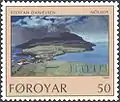 Nólsoy, Faroe Islands
Nólsoy, Faroe Islands
Artist: Steffan Danielsen
Issued: 8 Oct 1990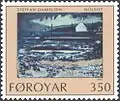 Nólsoy, Faroe Islands
Nólsoy, Faroe Islands
Artist: Steffan Danielsen Nólsoy village
Nólsoy village Nólsoy's whale-bone arch
Nólsoy's whale-bone arch Seafront at Nólsoy
Seafront at Nólsoy Faroese flag flying in Nólsoy village
Faroese flag flying in Nólsoy village
Gallery
 Position of Nólsoy village
Position of Nólsoy village Nólsoy
Nólsoy Nólsoy
Nólsoy Pumice from Nólsoy
Pumice from Nólsoy
References
- ↑ "Nólsoy in short".
- ↑ "Sedler og mønter: Tårnmønter". National Bank of Denmark. February 10, 2014. Retrieved September 25, 2015.
- ↑ "Korndalur (The Dale of Corn)". Nólsoy. Retrieved 1 June 2022.
- ↑ "The Corn Valley and the Princess Ruins". Welcome to Nólsoy. Visit Tórshavn. 31 July 2013. Retrieved 1 June 2022.
- ↑ Brandt, Don (2006). More stamps and the story of the Faroe islands. Postverk Føroya. p. 63. ISBN 99918-3-191-6.
- ↑ "The Climate of The Faroe Islands - with Climatological Standard Normals, 1961-1990 Greenland" (PDF). Danish Meteorological Institute. Retrieved August 19, 2015.
- ↑ Clarke, W.E., On some Forms of Mus musculus, Linn., with Description of a new Subspecies from the Faroe Islands 1904
- ↑ "Nolsoy". Ramsar Sites Information Service. Retrieved 25 April 2018.
- ↑ BirdLife International. (2012). Important Bird Areas factsheet: Nólsoy. Downloaded from http://www.birdlife.org on 2012-02-23.
External links
- faroeisland.dk
- http://visitnolsoy.fo/ "official" tourist info website
- personal website with 6 aerial photos of Nólsoy
- personal website of Jens-Kjeld Jensen - mainly about nature and wildlife on the Faroe Islands; also contains information about Nólsoy.